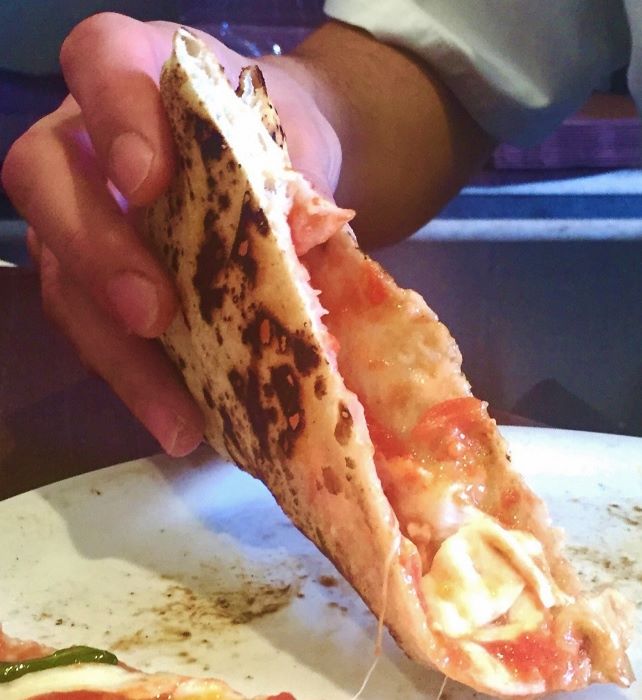- Local Guides Connect
- :
- Food & Drink
- How to identify a good pizza?
- Subscribe to RSS Feed
- Mark Topic as New
- Mark Topic as Read
- Float this Topic for Current User
- Bookmark
- Subscribe
- Mute
- Printer Friendly Page
04-10-2019 11:02 PM
How to identify a good pizza?
A good pizza is generally made by a good pizzeria. So the first thing we have to do is reaching the pizza making station. Let's try to not be enchanted by the pizzaiolo, his acrobatic manoeuvres with the daugh and the appeal of the fresh ingredients, let's give a look at his back, at the oven:

1) Try to spot its manufacture plate, and so if it is made in Italy. That is the first guarantee, also about the knowledge from the property.
2) The oven must be clean! During the production, the flower gets burnt and tent to form a dark layer on the surface of the oven. It is pizzaiolo's responsibility to clean it every tot pizzas.
3) The smoke doesn't have to accumulate in the oven's ceiling area, and it must not be in contact with the pizza.
4) If there is a pizzaiolo with exclusively oven mansions it will consistently improve the taste of a pizza. That because the cooking process is very fast, it takes 1 minute to cook a pizza, and so a lack of attention could result in a bad product.
Now that we have checked the pizzaiolo station we can have a seat and look at the menu. I am always pleased to look at a short menu, it usually means that ingredients are selected with attention and that they are fresh!

If we want to test the ability of the pizzaiolo we should order a Margherita, the mother of all the pizzas. The Margherita has few ingredients as a topping and it is easier to check for their quality:
1) Tomato passata should have the right balance between sweetness and acidity. If it is too sweet it was probably adjusted with sugar; this can indicate a bad ingredient selection and a bad attitude of the pizzaiolo that try to cheat on our tastebuds.
2) The mozzarella must be melted in a homogeneous way: when it looks like plastic or more like a cheese slice, you will surely find yourself in front of a low-quality product with a non-existent taste that will confirm it.
However, regardless of what you choose, once the pizza is on your plate, these checks will be done:
1) The first thing to consider is the profile of the pizza. When the surface is flat it is a good sign. It indicates a good porosity of the starting paste and a good "spread".
2) Once cut, observe the holes in the crust. Apart from existing and having an adequate size (no bubbles of champagne), they must be as round as possible without forming galleries.

3) To better evaluate a pizza we order a red one (with tomato passata) and a white one. The two pizzas must not have differences in riser and honeycomb. In fact, that means that the dough doesn't get moist in a humid environment (tomato passata) and doesn't lose too much water in a dry environment.
4) The pizza should be cut into 4 slices to fold with your hands. The end of the slice should not bend downwards, nor should have a different consistency than the dough near the edge.

5) The pizza dough has to be evaluated at least 12 hours after eating it. At this time we should not notice an increase in thirst or, worse, the revival of its flavour (that indicate hard digestion).
Those are the parameters that I use to evaluate the pizzas I eat all around the world.
- Mark as New
- Bookmark
- Subscribe
- Mute
- Subscribe to RSS Feed
- Permalink
- Report Inappropriate Content
More Food & Drink
-
malhazza
الدمام السعودية - Apr 24, 2024User Inserted Imageالغداء في مطعم عراقي بمدينة الدمام بصحبة أخي
تناول الطعام العراقي بتجربة ثرية بالتذوق حيث بعد يوم عمل طويل هاتفت اخي للقاء به في احد المطاعم في مدينة الدمام شرق المملكة العربية السعودية العاصمة الإدارية وصلنا إلى المطعم بعد تحديد الموقع بخرائط ق...1 -
MdSunnyHbk
Dhaka, Banglade - Apr 23, 2024User Inserted ImageBanani's Culinary Gem: Nori's Fusion Delights
Nestled in the bustling neighborhood of Banani 11 in Dhaka, Bangladesh, Nori beckons to all who seek an unforgettable culinary experience. As I stepped into the restaurant, I was immediately envelope...7 -
Oliver-guide
Dubai - United - Apr 23, 2024User Inserted ImageSushiart restaurants Dubai marina JBR
Had a great time, food was very good and tasty. Had an amazing service. We went during the all you can eat special after 18h. Would really recommend if you are in the area and have a sushi craving.8